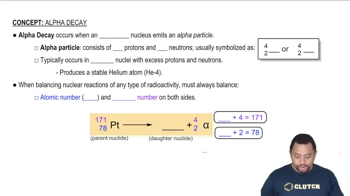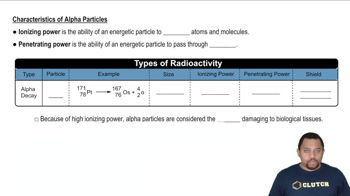Here are the essential concepts you must grasp in order to answer the question correctly.
Nuclear Decay
Nuclear decay is the process by which an unstable atomic nucleus loses energy by emitting radiation. This can occur in various forms, including alpha decay, beta decay, and gamma decay. In alpha decay, the nucleus emits an alpha particle, which consists of two protons and two neutrons, resulting in a new element with a lower atomic number.
Recommended video:
Alpha Particle
An alpha particle is a type of ionizing radiation ejected from the nucleus during alpha decay. It is composed of two protons and two neutrons, making it identical to a helium nucleus. The emission of an alpha particle decreases the atomic number of the original nuclide by two and the mass number by four, leading to the formation of a different element.
Recommended video:
Characteristics of Alpha Particles
Nuclear Equation
A nuclear equation represents the transformation of one nuclide into another during a nuclear reaction. It includes the symbols for the reactants and products, along with their respective atomic numbers and mass numbers. For alpha decay, the equation typically shows the original nuclide, the emitted alpha particle, and the resulting nuclide, ensuring that both mass and charge are conserved.
Recommended video:
 Verified step by step guidance
Verified step by step guidance


